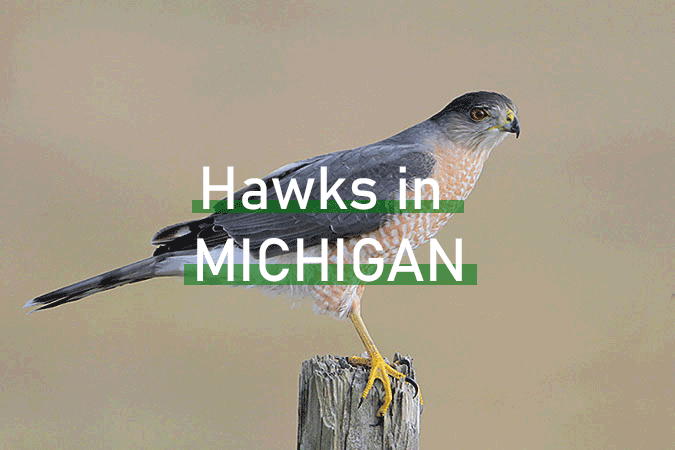
Michigan is a great state to see hawks!
Several species breed and many hawks migrate through and winter in the state.
In Michigan, hawks are seen in forest, open fields, and even visit backyards.
Which hawks do you see in your Michigan neighborhood? See this article to find out how to identify those birds of prey!
On this page
Hawks in Michigan
According to eBird data, nine hawk species are regular breeders or visitors to the state, and two more are rare migrants.
That’s a lot of hawks in Michigan! However, we know it can be a challenge to identify these cool birds. To help, we researched eBird data to make a list of hawks of Michigan arranged from most common to least common.
We also included field mark tips and information to help you identify them. Enjoy!
Red-tailed Hawk (Most Common Hawk in Michigan)
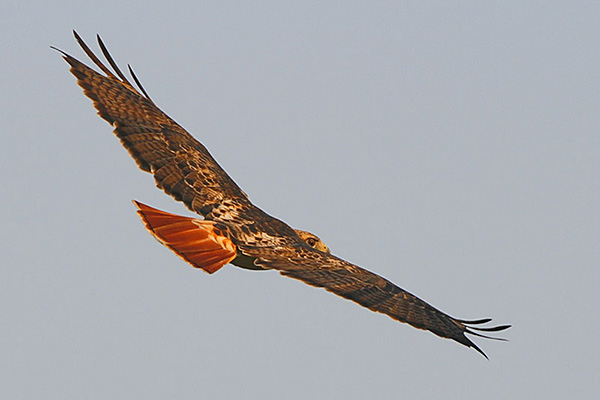
Scientific name: Buteo jamaicensis
Length: 19 inches
Weight: 2.4 pounds
Wingspan: 49 inches
Song: “Kreeeyahh!”
The Red-tailed Hawk is a large and chunky raptor with a broad, orange or reddish tail. Males and females look alike although females are larger.
These raptors are dark brown above and are pale below with dark markings on their belly. Young birds are more streaked on their underparts, and have brown tails with dark barring.
Red-tailed Hawks often soar and have long, broad wings that can show pale square patches on the bases of their primaries. While soaring, they watch for squirrels and other small animals that they feed on.
When they spot prey, these big birds drop down to catch it with their talons. This hawk also hunts by watching for prey from a perch.
The Red-tailed Hawk builds a large, bulky, stick nest high in trees. They thrive in a wide variety of habitats but especially in woodlands near fields and other open habitats.
This raptor lives from Alaska and Canada south to Central America.
Key Identifications:
- Large, bulky hawk with a broad, reddish tail.
- Catches squirrels, rats, pigeons, and many other small animals on the ground.
- Nests in large, bulky nests made of sticks.
- A vocal raptor, Red-tailed Hawks often call in flight. They usually give a “classic” but quiet sounding raptor scream, “Kreeeyahh!”.
Red-tailed Hawks are large dark brown and pale hawks with broad, reddish tails. The most common raptor in many areas, they often perch on powerline poles along roads. The Red-tailed Hawk’s vision is eight times better than a person’s; they can spot a tiny rodent while soaring 100 feet above it.
Cooper’s Hawk
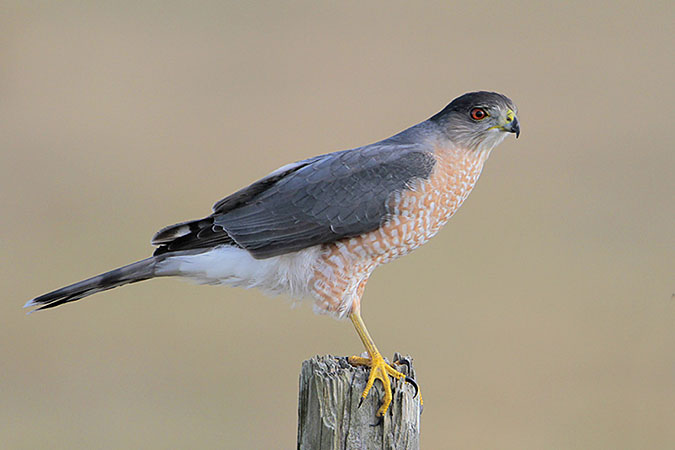
Scientific name: Accipiter cooperii
Length: 16.5 inches
Weight: 1 pound
Wingspan: 31 inches
Song: “kek kek kek kek kek kek kek”
The Cooper’s Hawk is a fair-sized hawk with rounded wings and a long, rounded tail. Adults are blue-gray above and have orange barring below. In common with most raptors, males are smaller than females.
They also have a somewhat square-shaped head with a darkish cap, pale nape, and a few dark bars on their tail. In flight, the head of the Cooper’s Hawk extends out from the body and it has deep flaps between brief glides.
Juveniles are brown above and have fine dark streaks on white underparts.
This raptor feeds on squirrels, doves, starlings, and other small mammals and medium-sized birds. It catches prey with its talons after a quick pursuit. They often attack birds at feeders.
The Cooper’s Hawk uses sticks to make a bulky nest high in a tree.
This species lives in forest and a variety of semi-wooded habitats (including urban areas) in southern Canada and most of the USA, including Michigan.
Key Identifications:
- Slender but hefty raptor with blocky head and long, rounded tail. Adults are gray above and orange below, juveniles are dark brown above and have dark streaks on white underparts.
- Preys on doves, starlings, and small mammals.
- Builds a bulky stick nest high in a tree.
- Makes a loud, barking call, “kek kek kek kek kek kek kek”.
The Cooper’s Hawk is a fair-sized, long-tailed hawk with a blocky head. This species hunts medium-sized birds and small mammals in forest, semi-wooded habitats, and wooded urban areas. In the mid 20th century, populations of this raptor were heavily affected by DDT poisoning but it has since recovered and is common in most parts of its range.
Northern Harrier
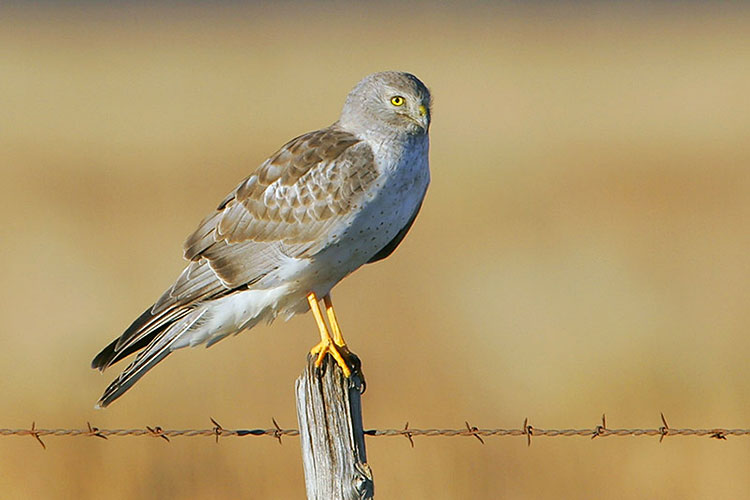
Scientific name: Circus hudsonius
Speed: 21-38 miles per hour
Length & Weight: 18 inches, 15 ounces
Wingspan: 43 inches
Call: “che che che che che che”
The Northern Harrier is a fair-sized, unique hawk with long wings, a long tail, and a white rump. Adult males have gray upperparts, head, and breast. They also have some pale brown spotting on their underparts and black tips on their wings.
Females are dark brown above and have dark brown streaks on pale underparts. Young birds are also dark brown above but have deep orange-buff underparts.
All Northern Harriers have a white rump and glide low over the ground on long wings held in a “V” shape.
This species preys on small animals caught on the ground, sometimes after hovering.
It uses grass and other vegetation to make a shallow, platform nest on the ground, in thick wetland or grassland areas.
Northern Harriers breed in grasslands and other open habitats in Alaska, Canada, California, and the northern and central USA. They winter in much of the USA, Mexico, and rarely to northern South America.
Key Identifications:
- Distinctive long-winged, long-tailed hawk with a white rump.
- Glides low over the ground to catch rodents and other small animals in marshes and other open grassy habitats.
- Builds a platform nest on the ground, in tall thick grass.
- Makes a repetitive, woodpecker-like call, “che che che che che che”
Northern Harriers are long-tailed, long-winged hawks with white rumps. They glide low over the ground of grasslands and marshes to hunt for small animals. This bird and the Hen Harrier of northern Eurasia used to be considered the same species but despite their similar appearance, studies have shown that the Northern Harrier is a distinct species.
Red-Shouldered Hawk
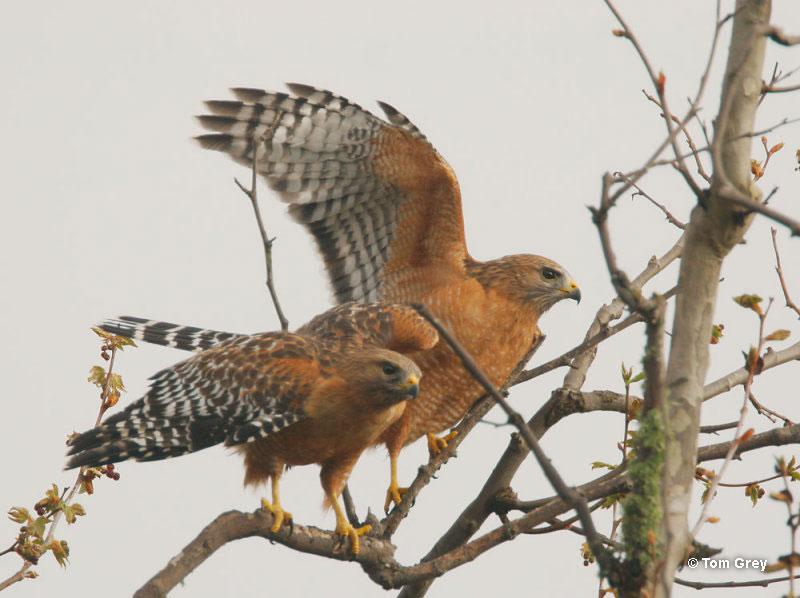
© Tom Grey
Scientific name: Buteo lineatus
Speed: 18-34 miles per hour
Length & Weight: 17 inches, 1.4 pounds
Wingspan: 40 inches
Call: “keer keer keer keer keer!”
The Red-shouldered Hawk is most common hawk in Florida. It is a medium-sized hawk with reddish-orange underparts and shoulder, and black and white on its wings and tail.
Both sexes are similar but as with most raptors, females are larger than males. Young birds are brown above and have dark streaks on pale underparts.
In flight, all ages of this hawk species are best recognized by their longish, black and white tail and long wings with a pale crescent-shaped mark near the tip of the wing.
Red-shouldered Hawks prey on snakes, frogs, and other small animals. They forage by waiting on a perch and then swooping down to catch the animal on the ground.
This species builds a bulky stick nest high in a tree in wooded and semi-wooded areas, often near wetlands.
The Red-shouldered Hawk lives in a variety of woodland habitats in southeastern Canada, the eastern USA, California, southeastern Oregon, and Baja California, Mexico.
Key Identifications:
- Medium-sized, colorful hawk with reddish-orange underparts and shoulder, and black and white upperparts and tail.
- Forages for snakes and other small animals on the ground in woodland habitats.
- Builds a bulky stick nest high in a tree.
- Makes loud, jay-like, ringing calls, “keer keer keer keer keer!”
The Red-shouldered Hawk is a medium-sized hawk with reddish underparts and shoulder, and a black and white tail. This raptor lives in a variety of wooded areas and even wooded neighborhoods in California and Florida. This species can join American Crows to harass and chase away Great-horned Owls.
Sharp-Shinned Hawk
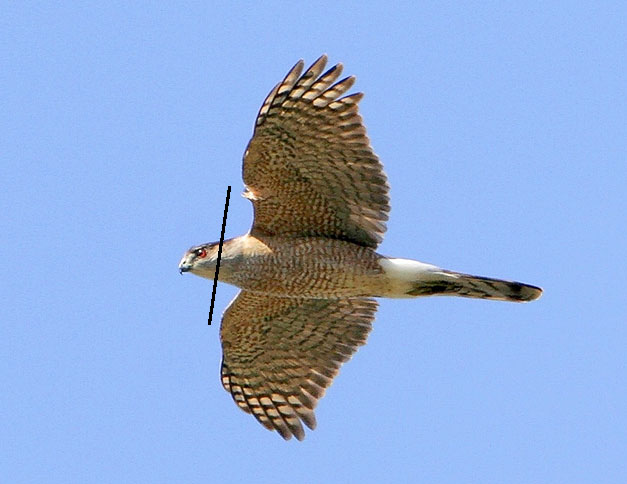
Scientific name: Accipiter striatus
Speed: 16-60 miles per hour
Length & Weight: 11 inches, 5 ounces
Wingspan: 23 inches
Call: “kew kew kew kew kew kew kew kew”
The Sharp-shinned Hawk is a small hawk with a long, rectangular tail and rounded wings. Adults have blue-gray upperparts, orange barring on their underparts, and dark bands on their tail.
Females are larger than males and young birds are dark brown above with thick brown streaks on pale underparts.
This species flies with several quick wing beats followed by brief glides. When flying, its head doesn’t stick out as much as a Cooper’s Hawk and it shows a square-tipped tail.
The Sharp-shinned Hawk preys on small birds up to the size of an American Robin. It mostly catches birds around the same size as sparrows, warblers, and vireos by quickly flying and catching them in vegetation.
This hawk builds a bulky stick nest high in a conifer.
Sharp-shinned Hawks live in wooded habitats in Alaska, much of Canada and the USA, Mexico, parts of Central America, the Caribbean, and parts of South America.
Key Identifications:
- Small hawk with rounded wings and a long, rectangular tail.
- Preys on small birds in woodland habitats.
- Builds bulky stick nest high in a conifer.
- Usually quiet but on breeding grounds makes falcon-like, repeated ringing calls “kew kew kew kew kew kew kew kew”.
This small hawk with a long, rectangular tail breeds in coniferous forests and winters in a range of wooded habitats. It often attacks small birds at feeders. The Sharp-shinned Hawk gets its name from its thin legs that have angled, “sharp” shins.
Rough-legged Hawk
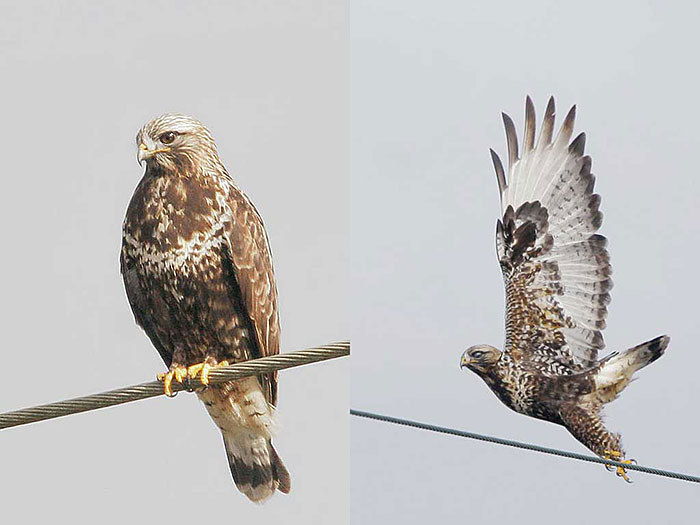
Photograph © Tom Grey
Scientific name: Buteo lagopus
Speed: 22-28 miles per hour
Length & Weight: 22 inches, 1.3 to 3.6 pounds
Wingspan: 53 inches
Call: “reeaaaauh!”
The Rough-legged Hawk is a long-winged hawk with a black and white tail. There are two color morphs; both with broad white patches near dark wing tips, and a longish pale tail with a broad black tip.
Pale females and juveniles are pale gray-brown with a black belly and black “wrists” in their wings. Pale adult males are more cold gray, have less black on their belly, and heavily streaked breasts.
Dark females and juveniles are dark brown except for their tail and flight feathers. Dark adult males are black except for their flight feathers and tail.
In flight, this species holds its wings in a shallow “V”.
Rough-legged Hawks soar and hover over open fields where they prey on voles and other small animals.
It builds a bulky nest on a cliff or rocky outcropping.
The Rough-legged Hawk breeds in tundra in Alaska, northern Canada, and northern Eurasia, and winters in open fields in southern Canada, the northern, central, and western USA, and Europe and Asia.
Key Identifications:
- Big hawk with a longish black and white tail, and long wings with broad white patches near the dark wing tips.
- Preys on rodents and other small animals in wide open habitats.
- Builds a big, bulky nest on cliffs and rocky outcroppings in tundra.
- Makes a loud, clear descending call, “reeaaaauh!”.
The Rough-legged Hawk is a big, long-winged hawk with a black and white tail, and broad white patches near the tips of their wings. They hover and soar over weedy fields and other open habitats to hunt for rodents and birds. This species is one of the only hawks in North America that has feathers on its legs.
Broad-winged Hawk
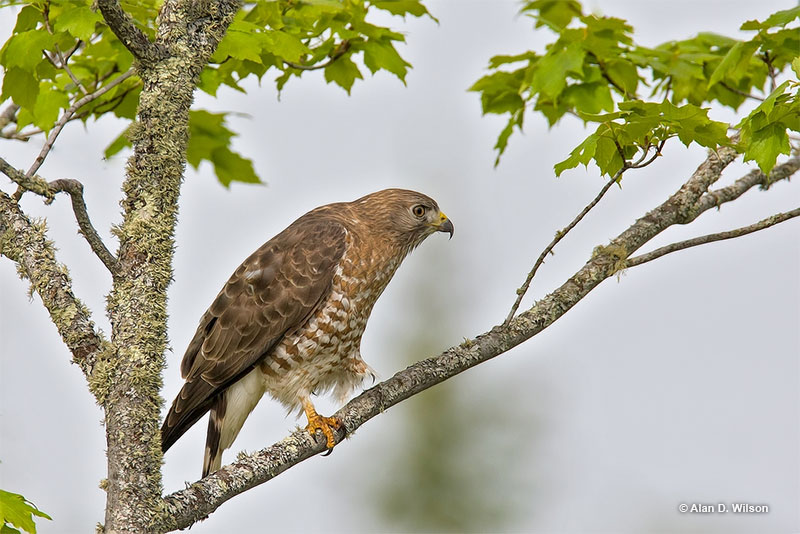
Scientific name: Buteo platypterus
Speed: 20-40 miles per hour
Length & Weight: 15 inches, 14 ounces
Wingspan: 34 inches
Call: “sipeeeeeeeee”
The Broad-winged Hawk is a smallish raptor around the same size as a crow. Adults are dark brown above, have dark, reddish-brown barring below, and a broad tail with a few wide, white bands.
Both sexes look the same and also have a thick dark mark on each side of their throat although females are larger. Young birds have dark brown streaks on pale underparts.
In flight, this species often soars, shows a broad black and white tail, and has long wings shaped like a “paring knife” that also have a dark trailing edge.
This raptor preys on voles, frogs, insects, and other small animals. It catches food by waiting on a perch and then quickly swooping down to the ground.
Broad-winged Hawks make a bulky stick nest high in a tree.
This small hawk breeds in forest habitats in central and southeastern Canada and much of the eastern USA. It winters in southern Florida and Mexico south to Bolivia.
Key Identifications:
- Chunky, smallish, crow-sized hawk with a few white bands on its tail and underparts with brown barring or streaks.
- Preys on insects and small animals in woodland habitats.
- Builds a bulky nest high in a tree.
- Makes a high-pitched call, “sipeeeeeeeee”
This chunky, crow-sized hawk has a few prominent white bands on its broad tail and either dark barring below or dark streaks. It often soars above and near woodland habitats. In southern Texas and some other places, thousands of Broad-winged Hawks can be seen as they migrate between breeding and tropical wintering grounds.
Swainson’s Hawk
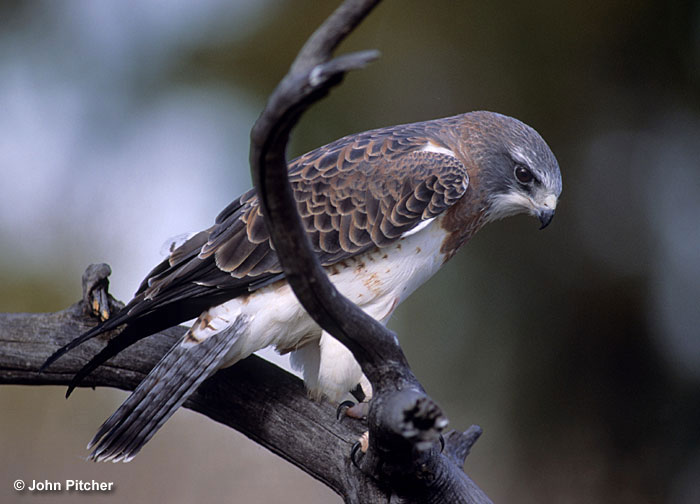
Scientific name: Buteo swainsoni
Speed: 15-60 miles per hour
Length & Weight: 19 inches, 1.9 pounds
Wingspan: 51 inches
Call: “eeeah!”
The Swainson’s Hawk is a big hawk with dark-brown upperparts, long, pointed wings with dark flight feathers, and a broad tail with fine dark barring and a dark tip. Males and females are similar although females are larger.
Adults can have a white throat, front, wing linings, and underparts with a red-brown breast. They can also have a white throat and front, and reddish brown underparts and wing linings, or be entirely dark brown.
Young birds can have dark markings on pale underparts or be mostly dark below.
This species catches grasshoppers and small animals on the ground. It forages by soaring and then swooping down or walking on the ground.
It builds a bulky stick nest in a tree.
Swainson’s Hawks breed in grasslands, meadows, and other open habitats in central and western Canada and the USA. They migrate through the central USA and winter in grasslands in Argentina. A few also migrate through and winter in southern Florida.
Key Identifications:
- Large, long-winged hawk with dark flight feathers and a broad tail with fine dark banding and a dark tip.
- Feeds on insects and small animals in prairies and other open habitats.
- Builds a bulky stick nest in a tree.
- Makes a loud, descending, single note, “eeeah!”.
The Swainson’s Hawk is a large, long-winged raptor with dark flight feathers and some white on the rump. It soars above and perches in trees, and on the ground in prairies and other open habitats. This species migrates from western North America all the way to grasslands in Argentina.
Ferruginous Hawk (Rare)
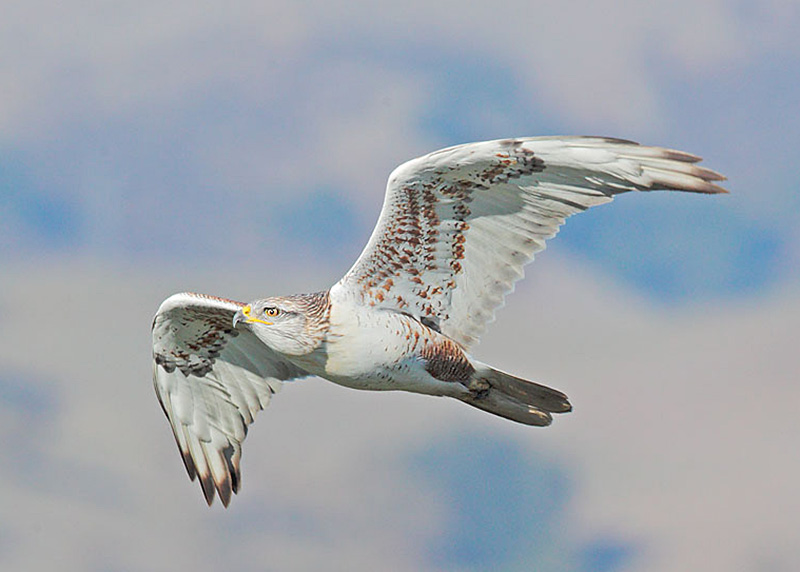
Photograph © Tom Grey.
Scientific name: Buteo regalis
Speed: up to 150 miles per hour
Length & Weight: 23 inches, 2.3 pounds
Wingspan: 55 inches
Call: “reeaaaauh!”
The Ferruginous Hawk is a big hawk with a pale tail, long wings, and feathered legs. There are two color morphs.
Adults can be white below with red-brown on their wing linings and flanks. They also have reddish-brown legs and are reddish-brown and pale gray above. Dark morphs are dark brown with a pale tail and pale flight feathers.
Juveniles are paler below and lack reddish-brown colors.
In flight, it soars with wings held in a shallow “V”. Pale primary patches are also visible on the upper sides of each wing.
The Ferruginous Hawk preys on prairie dogs and other mammals but can also catch waterfowl. It waits on the ground, low perch, or flying low and then snatching prey with its talons.
It builds a big, bulky stick nest in a lone tree, or on a rock outcropping or other structure.
This raptor lives in wide open habitats in south-central Canada, the western USA and northern Mexico.
Key Identifications:
- Big pale or dark hawk with long wings and a pale tail.
- Preys on prairie dogs, other mammals, and waterfowl in wide open habitats.
- Builds a big and bulky stick nest in an isolated tree or other structure.
- Makes a hoarse, descending call, “reeaaaauh!”.
The Ferruginous Hawk is a big, eagle-like, pale raptor with reddish-brown and gray upperparts. It can also be dark brown with a pale tail and pale flight feathers, and lives in prairies and other wide open habitats. “Ferruginous” means “rust-colored” and refers to the reddish plumage on their backs and legs.
Short-Tailed Hawk (Rare)
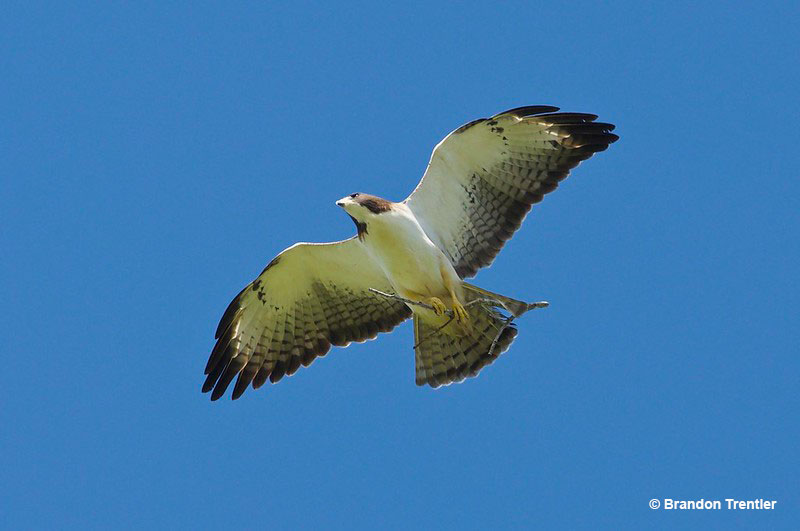
Scientific name: Buteo brachyurus
Speed: 20-40 miles per hour
Length & Weight: 16 inches, 15 ounces
Wingspan: 37 inches
Call: “reeeeeee!”
The Short-tailed Hawk is a small soaring raptor with two color morphs. It can have a hooded appearance and be dark above and pale below, or be mostly black. Both sexes look similar although females are larger than males.
In flight, it has a squared tail with some fine dark bands, and long wings with dark barring on the flight feathers and a thick dark trailing edge.
Young birds resemble adults but have a few marks on their breast or pale spotting below.
This species feeds on small birds, reptiles, and large insects. It catches prey by flying high in the air and then quickly dropping down to snatch the animal in vegetation or on the ground.
Short-tailed Hawks build a bulky stick nest high in a tree.
This tropical species uses forest and semi-open habitats from Mexico to Brazil. However, in North America, it is resident in Florida and a rare vagrant to southern Texas.
Key Identifications:
- Small soaring hawk that is dark above and pale below or mostly black.
- Preys on small birds, lizards, and other small animals in various subtropical habitats of Florida.
- Builds a bulky stick next high in a tree.
- Makes a drawn out clear call, “reeeeeee!”, usually while soaring high overhead.
The Short-tailed Hawk is a small soaring raptor with two color morphs; birds that are pale below and dark above or mostly black.
How To Identify Hawks?
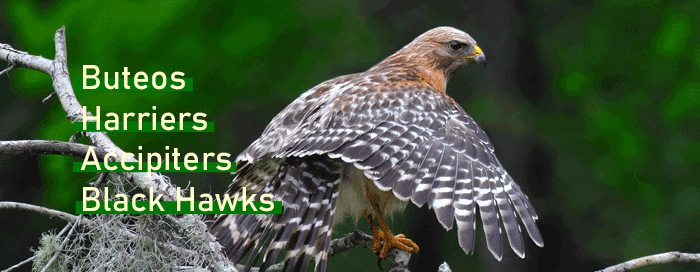
Hawks are easy to see but can be tough to identify! Don’t give up! With practice and knowing what to look for, recognizing hawks becomes easier than you think.
The first step is knowing how to recognize the four main groups of hawks. In flight, each of these types of hawks has a certain shape and way of flying. They are:
- Buteos and Buteo-like Hawks – Long, broad wings and a broad tail.
- Accipiters – Shorter, rounded wings and a long tail. They fly with quick flaps followed by brief glides.
- Harriers – Long wings, a long tail, and a white rump. They glide near the ground with their wings held in a “V”.
- Black-Hawks – Chunky, dark, tropical hawks with broad wings and a short, broad tail.
After we categorize a raptor in one of these groups, we can focus on other details like:
- The pattern on the tail and underparts.
- More details about its shape.
- The pattern in the wings.
- The habitat and location of the bird.
For example, if we see a hawk with a long tail and rounded wings, we know it’s an Accipiter. If it has a rounded tail, orange underparts, and blocky-head, we can call it a Cooper’s Hawk.
FAQ of Michigan Hawks
What kind of hawks lives in Michigan?
Ten species of hawks live in Michigan. There are big resident species like the Red-tailed Hawk, winter visitors like the Rough-legged Hawk, and the Cooper’s Hawk, a swift hawk that can prey on birds at feeders.
Are there hawks in Detroit?
Yes, there are hawks in Detroit. Red-tailed Hawks and Cooper’s Hawks live in the city and other species migrate through and visit during the winter months.
What is the biggest hawk in Michigan?
The biggest hawk in Michigan is the Ferruginous Hawk. This rare visitor to the state is 23 inches long and weighs 3.5 pounds.
Let us know in the comments which hawks you have seen in Michigan!

